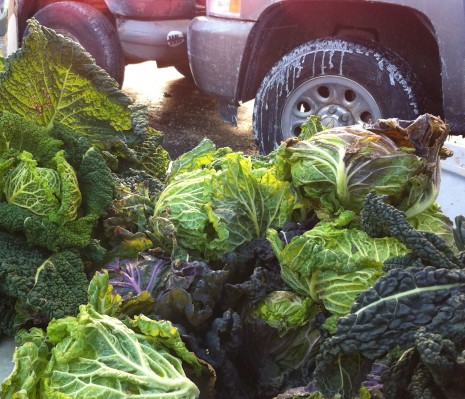FROSTBITTEN GREENS: A MARKET STORY
It was bound to happen sooner or later: The temperature dipped down into the single digits and made itself at home. Last Saturday’s trip to the Union Square Greenmarket began, then, with swathing myself in Heattech—Uniqlo’s fabulously comfortable thermal line of turtlenecks, T-shirts, leggings, and socks. Forgive the shameless plug, but the stuff really works, and is one of my keys to getting through the winter.
This time of year, my market expeditions are more about foraging than shopping, but never mind. I only needed the basics: potatoes, onions, carrots, perhaps some Nordic rye bread. I didn’t expect to see my apple guy; he won’t transport the fruit in weather like this, or it will freeze in the truck. “A frozen apple is a mushy apple,” he would say. “And worthless.” I found myself hoping that he’d taken the opportunity to sleep in.
And I was eager to see what was heaped on the tables at Northshire Farm, from (way) upstate New York. Grower Jim Grillo is renowned for his greens, among other things, and sure enough, I hit the jackpot: He’s still harvesting savoy cabbages, with their hoop skirts of crinkled leaves, and kale from beneath a deep, insulating blanket of snow. Although the leaves were brittle to the touch and a little worse for wear, they looked like a world of deliciousness to me. By the way, the strappy, inky-green leaves of lacinato kale (at far right in above photo) are also savoyed, or crinkled, and taste like Tuscany.
In fact, even though the summer months bring charming little bunches of young kale to the market, I find them as fundamentally uninteresting as tomatoes in January. Like all brassicas, kale and cabbage need a hard frost to bring out their deeply sweet character: They survive by releasing more natural sugars into the water inside their leaves, thus lowering the temperature at which freezing begins. Pretty tricky … and worth waiting for.
Savoy cabbage and kale cook quickly if you stack the leaves, roll them up into a cylinder, and cut them into thin strips crosswise. If you’ve ever had the Brazilian dish called collards Miniera, you’ll know what I mean. Here, the greens are bolstered with sausages. I used fat, mildly seasoned pork sausages, but a spicier variety would work well, too. And although I call for Savoy cabbage and lacinato kale below because that is what I used, I imagine any pot green that doesn’t shrink down too much would be good. I’ve made variations on this dish for years, but, as always, am standing on the shoulders of giants. I have a feeling that I was originally inspired by Marcella Hazan, who combines her sausages with red cabbage.
Pork Sausages with Cabbage and Kale
This is wonderful with polenta or simply a heap of buttery, garlicky toast.
1 pound pork sausages
Extra-virgin olive oil
About 1½ pounds total Savoy cabbage and lacinato kale
About 1 tablespoon chopped garlic
Coarse salt and freshly ground pepper
1. Prick the sausages in a few places with a fork and put them in a skillet. Brown them well over moderate heat, turning them, and if the fat oozing out of them doesn’t seem like enough, add a little oil. Don’t rush this first step—browning is what provides you with a bedrock of flavor. Plus, it smells wonderful.
2. While the sausages are working, cut the center ribs out of the cabbage and kale if they are especially tough and fibrous; otherwise, don’t worry about them. Stack a few cabbage leaves at a time, roll them into a cylinder, and cut crosswise into thin strips. Do the same with the kale. Keep the greens separate.
3. Sausages done? Good. Transfer them to a plate. If there doesn’t seem to be enough fat in the skillet, add some oil, then sauté the garlic until pale golden and fragrant. The cabbage will take longer to cook than the kale, so add a few handfuls of that first and cook, tossing with tongs, until wilted. Gradually add the rest of the cabbage and then the kale, letting each batch wilt before adding the next. Cover the pan intermittently; the steam that creates will speed things along, and if the pan looks dry, pour in a little water; you don’t want the greens to scorch.
4. Once all the greens are on their way to soft, season with salt and pepper and return the sausages to the pan. Let the sausages and greens get along with each other for a while, uncovered, until the greens are truly soft and yielding, a good 20 minutes.
Posted: January 28th, 2013 under cooking, Market Stories, people + places, recipes, winter.


